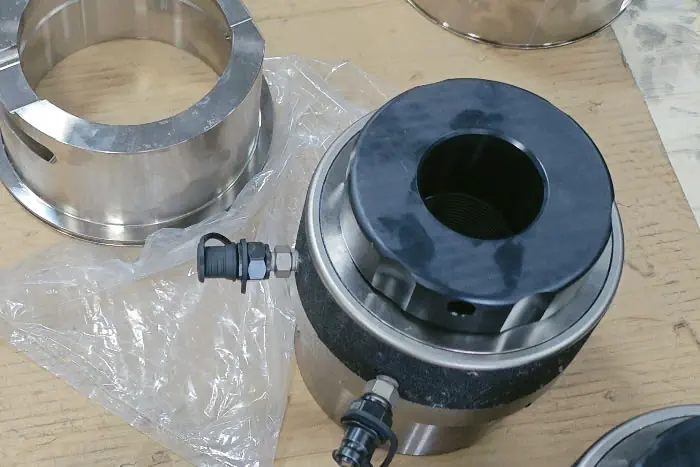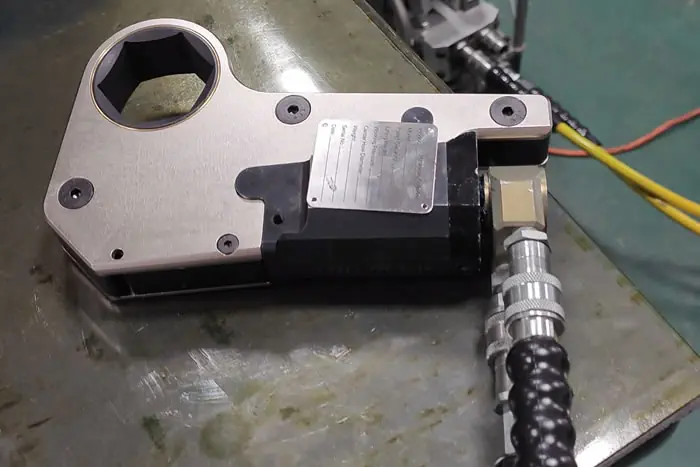Hydraulic Bolt Tensioning vs Torquing: Which Method Ensures Reliable Flange Preload?
Introduction — Why Torque and Tension Matter
Tightening bolts may appear simple, but the chosen method defines joint safety and service life. Understanding the difference between torque and tension is essential for engineers, maintenance teams, and procurement specialists. This technical guide explains hydraulic bolt tensioning and torquing, compares their benefits and limitations, and helps you decide when to specify SAIVS tensioners or Torque Tools for your project.


Torque vs Tension: The Fundamental Difference
Torque measures rotational force used to turn a nut or bolt head.
Tension is the axial load that stretches the bolt, generating the clamping force that holds joint faces together.
Because friction in threads and under the nut converts only part of applied torque into tension, torque readings do not always correspond directly to bolt preload.
What Is Hydraulic Bolt Tensioning?
Hydraulic bolt tensioning stretches the bolt directly to a precise axial load using a hydraulic tensioner.
The nut is snugged against the flange while Hydraulic Pressure maintains the preload, then the nut is turned down and pressure released so the bolt transfers the load to the nut.
This method is a preferred industrial standard where load consistency and repeatability are critical.
How Hydraulic Bolt Tensioning Works — Step by Step
A hydraulic tensioner is fitted over each stud or bolt.
Hydraulic pressure is increased to elongate the bolt to the target tension.
While the bolt is stretched, the nut is run down to the flange face.
Hydraulic pressure is released so the bolt attempts to return to original length, locking the required preload into the joint.
Advantages of Hydraulic Tensioning
High preload accuracy and excellent repeatability across multiple bolts.
Ability to tension several bolts simultaneously for even load distribution on flanges.
No torsional stress on the bolt shank, reducing risk of thread galling or bolt fracture.
Ideal for large diameter studs and critical, high-pressure joints in power generation, oil & gas, and heavy manufacturing.
Limitations of Hydraulic Tensioning
hydraulic tensioners and supporting equipment have a higher upfront cost than standard torque tools.
Operators require training to correctly select and use tensioners, including attention to thread condition and flange geometry.
Some bolt and flange configurations provide limited clearance for a tensioner sleeve.
What Is Torquing?
Torquing uses a Torque Wrench to apply a rotational force to the nut, with friction converting that rotation into axial preload.
It’s a long-established method for many industrial bolting tasks and remains widely used for fasteners where precision tension control is less critical.
How Torquing Works — Key Points
The nut is rotated along the threads with a calibrated torque tool.
Thread friction and bearing surface friction consume part of the applied torque.
The remaining energy produces axial tension in the bolt, creating the clamping force required for the joint.
Advantages of Torquing
Simple to execute with minimal operator training.
Tools are compact, portable, and lower cost than hydraulic tensioning systems.
Widely applicable across diverse bolt sizes and joint geometries, particularly for smaller-diameter fasteners.
Disadvantages of Torquing
Friction variability causes scatter in achieved preload for the same nominal torque value.
Risk of over-stressing the bolt if lubrication or thread conditions change.
Less reliable for large studs and critical pressure-retaining joints where precise preload is mandatory.
When to Use Torquing vs Hydraulic Tensioning
Choose Torquing For:
Smaller bolt diameters (commonly under 1 inch).
Applications where preload accuracy is less critical.
Projects with limited budget or where portability is paramount.
Routine assembly or maintenance where speed and simplicity matter.
Choose Hydraulic Tensioning For:
Large-diameter studs and critical joints in pressure vessels, high-pressure flanges, and rotating equipment.
Situations requiring tight preload tolerances and even distribution across bolt groups.
When simultaneous tightening of multiple bolts is an advantage to reduce flange distortion.
Environments where minimizing torsional stress on fasteners extends service life.
Industry Use Cases
Oil & Gas: High-pressure flanges and critical pipeline joints benefit from hydraulic tensioning for safety and leak prevention.
Power Generation & Nuclear: Critical bolting on steam, turbine, and reactor components frequently specifies tensioning due to strict preload requirements.
Aerospace & Heavy Manufacturing: Torquing remains common for smaller fasteners, while tensioning is used where larger studs demand precise preload.
Selecting the Right Tool from SAIVS
SAIVS supplies both torque and tensioning solutions to match project requirements.
For projects where accuracy, repeatability, and reduced bolt stress are priorities, SAIVS hydraulic tensioners deliver industrial-grade performance and safety.
When portability, cost-effectiveness, and flexibility are required, SAIVS torque wrenches provide reliable service with easy handling and calibration support.
Our technical team can help you select the proper tool based on bolt diameter, joint design, flange type, and maintenance cadence.
Practical Procurement Checklist
Confirm bolt diameters and thread condition before specifying tools.
Review joint criticality and required preload tolerance with engineering.
Consider simultaneous tensioning needs to reduce flange distortion and save assembly time.
Factor in operator training and tool calibration requirements when budgeting procurement.
Ask SAIVS for application-specific advice, on-site demonstrations, and calibration services to ensure long-term reliability.
Conclusion — Which Method Is Best?
There is no single “best” method for every scenario.
Hydraulic bolt tensioning excels where precision, consistency, and reduced bolt stress are mission-critical.
Torquing remains a versatile, economical choice for many routine applications and smaller fasteners.
For critical industrial joints and large-diameter studs, specify SAIVS hydraulic tensioners.
For general assembly and maintenance, SAIVS torque tools offer excellent value and portability.
Contact SAIVS to evaluate your bolting needs and secure the right solution for safe, reliable joints.
Why Choose SAIVS™ as Your Supplier?
With 20 years of industry experience, SAIVS is a leading Chinese manufacturer of high-quality tools, offering competitive pricing and excellent customer service.We pride ourselves on exceptional quality control, extensive experience, and comprehensive after-sales service.